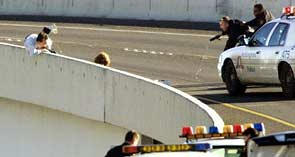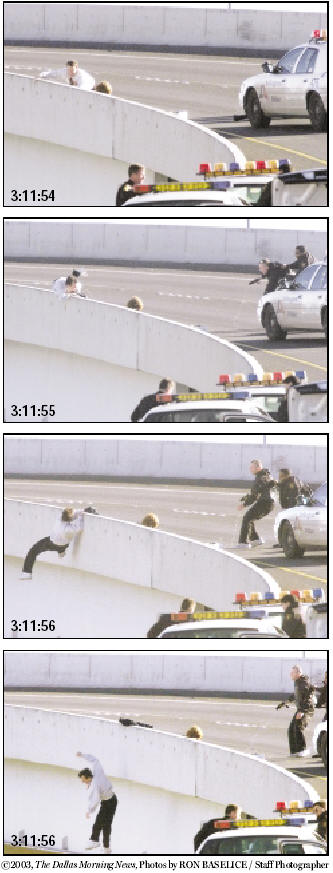

Stun gun shot preceded man's suicide Moments before New Year's Eve tragedy in Arlington 01/04/2003
ARLINGTON An Arlington police officer fired an electrical stun gun at a distraught man just moments before he jumped to his death from a highway overpass on New Year's Eve, an analysis of photos taken by The Dallas Morning News shows.
A photographer for The News recorded the events leading up to the suicide of Ronald E. Wright, a 35-year-old Grand Prairie man.
The photos show a police officer pointing a stun gun at Mr. Wright. Electrical wires extend from the pistol's barrel and drape across the 10-foot expanse between the officer and Mr. Wright. Sgt. Will Johnson, an Arlington police spokesman, saw the photographs on Friday but declined to confirm that an officer fired a stun gun at Mr. Wright. The brief police report that is publicly available made no mention of the use of a stun gun.
Several members of Mr. Wright's family said police officers came to their home and told them that a stun gun had been used during the incident.
"I think the [stun gun] was a poor idea," said Russell Wright, Ronald Wright's older brother. "They had him on the ground chitchatting with him. They had talked to him calmly for three hours and with one incident blew the whole deal."
Police Department policy prohibits discussing tactics because doing so could endanger the lives of the public or officers, Sgt. Johnson said.
"Based on the current information we have, we believe the decisions made and the resources used were appropriate," he said. "However, our response to this incident is currently being evaluated internally."
Statistics are not available for what percentage of police departments allow officers to carry stun guns. Departments across the country have purchased the devices for their tactical squads and patrol officers. In some cases, the guns are used to subdue suspects. They also can be an alternative to deadly force in hostage and standoff situations and occasionally have been used to thwart suicide attempts.
In the Arlington incident, seconds after the police officer fired the stun gun, Mr. Wright propelled himself over a waist-high concrete retaining wall atop the overpass where State Highway 360 and Interstate 20 come together. He fell an estimated 100 feet and was pronounced dead at the scene.
Family members were preparing for Mr. Wright's funeral set for Saturday. They declined to discuss his state of mind or possible reasons why he took his life.
How it works A stun gun is designed to incapacitate but not seriously injure a person. It fires two darts attached to separate wires that deliver the electrical charge. According to one manufacturer, the stun gun can be effective even if only one of the two darts hits its target.
An online manual for one brand of stun gun says that the full shock can still be delivered even if one dart falls on the grass or dirt. But the manual also warns that "results depreciate substantially" if a dart falls on asphalt or concrete.
Mr. Wright's leap, witnessed by dozens of onlookers, ended a three-hour standoff with police negotiators. They had managed to get within a few feet of him as they tried to talk him down to safety. Earlier this week, police said Mr. Wright became agitated when he saw a television news truck pull up near the overpass. Shortly afterward, he jumped.
The incident began about 12:19 p.m. on New Year's Eve. Arlington police received several 911 calls from people who reported seeing Mr. Wright running in and out of traffic.
When officers arrived, he was perched atop the concrete wall on the overpass feeding southbound 360 traffic onto eastbound Interstate 20. During the standoff, he repeatedly got up on the wall and then came down.
Police blocked traffic in all directions, backing up vehicles for miles. Rubbernecking motorists pulled onto the side of access roads around the scene. Some used high-powered binoculars to get a better look at the drama unfolding.
Police then began clearing the crowds to keep traffic moving, but people continued to park on medians and near High Point Church just northwest of the standoff.
At 2:30 p.m., Mr. Wright got off the ledge and slid to a sitting position next to the retaining wall seemingly out of harm's way. A police negotiator sat a few feet away from him.
Thirty minutes later, he rose again and straddled the wall, one leg hanging over the side. Police said Mr. Wright expressed concern with a television news van that had pulled up within his line of sight near High Point Church, about a quarter mile away.
Police Lt. James Hawthorne, the department's lead negotiator, radioed that someone needed to ask the van to move. A few seconds later, the Arlington police officer fired the stun gun. Mr. Wright dressed in shirt, tie, dark pants and white athletic shoes jumped to his death at 3:12 p.m.
Emergency medical workers in an ambulance below could do nothing, police said. They draped a sheet over Mr. Wright's body. Linda Anderson, a spokeswoman for the Tarrant County medical examiner's office, said Mr. Wright died from blunt force injuries sustained in the fall. The manner of death is listed as suicide, she said.
Stun gun's role
News accounts tell of officers who have used stun guns to thwart suicide attempts. In June 2001, a Florida police officer used a stun gun to subdue an emotionally distraught 47-year-old woman who was threatening to hurl herself off a coastal causeway. Negotiators coaxed her away from the bridge's edge before the officer shot her with the stun gun. The tactic worked in that case.
Sgt. Bob Newton, a supervisor in the Dallas Police Department's tactical section, said every case is different.
Dallas police have tested stun guns but have never purchased them, Sgt. Newton said. "The [stun gun] might be a good choice with a jumper," he said. "But if you're on a bridge, maybe not. You might not get close enough to use it effectively. It has a place in such a situation, but that doesn't mean it's an overall answer either. It's one of the more difficult tactical situations you'll encounter." Sgt. Johnson described Mr. Wright's death as a "tragic incident."
"The Police Department does not like it when lives are lost," he said.
Roscoe Wright, Ronald Wright's father, said the Arlington police officers who came to his home after his son died were "professional, polite and courteous."
"They said if we have more questions, to contact them and they'll be glad to answer them," Mr. Wright said.
Staff writers Ed Housewright, Scott Parks and Tim Wyatt
contributed to this report.
How It Happened Ronald E. Wright, 35, jumped to his death Tuesday afternoon just seconds after an Arlington police officer fired a stun gun at him. Photographic images taken by The Dallas Morning News Ron Baselice show the electrical wires from a stun gun on the ground, and in subsequent images, an officer emerging from behind a patrol car with a stun gun drawn. In each image, the electrical wires are visible, though in different places because they were in motion. Arlington police declined Friday to confirm that an officer fired a stun gun at Mr. Wright, a Grand Prairie resident. The series of images was taken during a two-to-three-second span, which was documented internally by the digital camera. The times printed on the images at right were added electronically. Send mail to webmaster@theppsc.org with questions or comments about this web site.
©2004 The Police Policy Studies Council. All rights reserved. A Steve Casey design.
|

